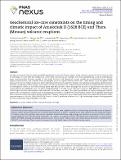Files in this item
Geochemical ice-core constraints on the timing and climatic impact of Aniakchak II (1628 BCE) and Thera (Minoan) volcanic eruptions
Item metadata
| dc.contributor.author | Pearson, Charlotte | |
| dc.contributor.author | Sigl, Michael | |
| dc.contributor.author | Burke, Andrea | |
| dc.contributor.author | Davies, Siwan | |
| dc.contributor.author | Kurbatov, Andrei | |
| dc.contributor.author | Severi, Mirko | |
| dc.contributor.author | Cole-Dai, Jihong | |
| dc.contributor.author | Innes, Helen | |
| dc.contributor.author | Albert, Paul G | |
| dc.contributor.author | Helmick, Meredith | |
| dc.date.accessioned | 2022-07-07T11:30:16Z | |
| dc.date.available | 2022-07-07T11:30:16Z | |
| dc.date.issued | 2022-05 | |
| dc.identifier | 279470124 | |
| dc.identifier | dbc0ebad-e343-4d9c-928e-e24f47e79409 | |
| dc.identifier | 85170565610 | |
| dc.identifier.citation | Pearson , C , Sigl , M , Burke , A , Davies , S , Kurbatov , A , Severi , M , Cole-Dai , J , Innes , H , Albert , P G & Helmick , M 2022 , ' Geochemical ice-core constraints on the timing and climatic impact of Aniakchak II (1628 BCE) and Thera (Minoan) volcanic eruptions ' , PNAS Nexus , vol. 1 , no. 2 , pgac048 . https://doi.org/10.1093/pnasnexus/pgac048 | en |
| dc.identifier.issn | 2752-6542 | |
| dc.identifier.other | ORCID: /0000-0002-3754-1498/work/115630949 | |
| dc.identifier.uri | https://hdl.handle.net/10023/25616 | |
| dc.description | This work was supported by funding from the European Research Council (ERC) under the European Union’s Horizon 2020 research and innovation programme (grant agreement 820047 to M.Si.), the Malcolm H. Wiener Foundation (Interdisciplinary Chronology of Civilizations Project to C.P.) and a UKRI Future Leader Fellowship (MR/S035478/1 to P.A). | en |
| dc.description.abstract | Decades of research have focused on establishing the exact year and climatic impact of the Minoan eruption of Thera, Greece (c.1680–1500 BCE). Ice cores offer key evidence to resolve this controversy, but attempts have been hampered by a lack of multi-volcanic event synchronization between records. In this study, Antarctic and Greenland ice-core records are synchronized using a double bipolar sulfate marker and calendar dates are assigned to each eruption revealed within the ‘Thera period’. From this global scale sequence of volcanic sulfate loading, we derive indications towards each eruption’s latitude and potential to disrupt the climate system. Ultra-fine sampling for sulfur isotopes and tephra conclusively demonstrate a colossal eruption of Alaska’s Aniakchak II as the source of stratospheric sulfate in the now precisely dated 1628 BCE ice layer. These findings end decades of speculation that Thera was responsible for the 1628 BCE event, and place Aniakchak II (52 ± 17 Tg S) and an unknown volcano at 1654 BCE (50 ± 13 Tg S) as two of the largest Northern Hemisphere sulfur injections in the last 4000 years. This opens possibilities to explore widespread climatic impacts for contemporary societies and, in pinpointing Aniakchak II, confirms that stratospheric sulfate can be globally distributed from eruptions outside the tropics. Dating options for Thera are reduced to a series of precisely dated, constrained stratospheric sulfur injection events at 1611 BCE, 1562-1555 BCE and c.1538 BCE which are all below 14 ± 5 Tg S, indicating a climatic forcing potential for Thera well below that of Tambora (1815 CE). | |
| dc.format.extent | 12 | |
| dc.format.extent | 1725654 | |
| dc.language.iso | eng | |
| dc.relation.ispartof | PNAS Nexus | en |
| dc.subject | Ice cores | en |
| dc.subject | Tree-rings | en |
| dc.subject | Tephra | en |
| dc.subject | Sulfate | en |
| dc.subject | Volcanic forcing | en |
| dc.subject | GE Environmental Sciences | en |
| dc.subject | DAS | en |
| dc.subject.lcc | GE | en |
| dc.title | Geochemical ice-core constraints on the timing and climatic impact of Aniakchak II (1628 BCE) and Thera (Minoan) volcanic eruptions | en |
| dc.type | Journal article | en |
| dc.contributor.institution | University of St Andrews. School of Earth & Environmental Sciences | en |
| dc.contributor.institution | University of St Andrews. St Andrews Isotope Geochemistry | en |
| dc.identifier.doi | https://doi.org/10.1093/pnasnexus/pgac048 | |
| dc.description.status | Peer reviewed | en |
This item appears in the following Collection(s)
Items in the St Andrews Research Repository are protected by copyright, with all rights reserved, unless otherwise indicated.

